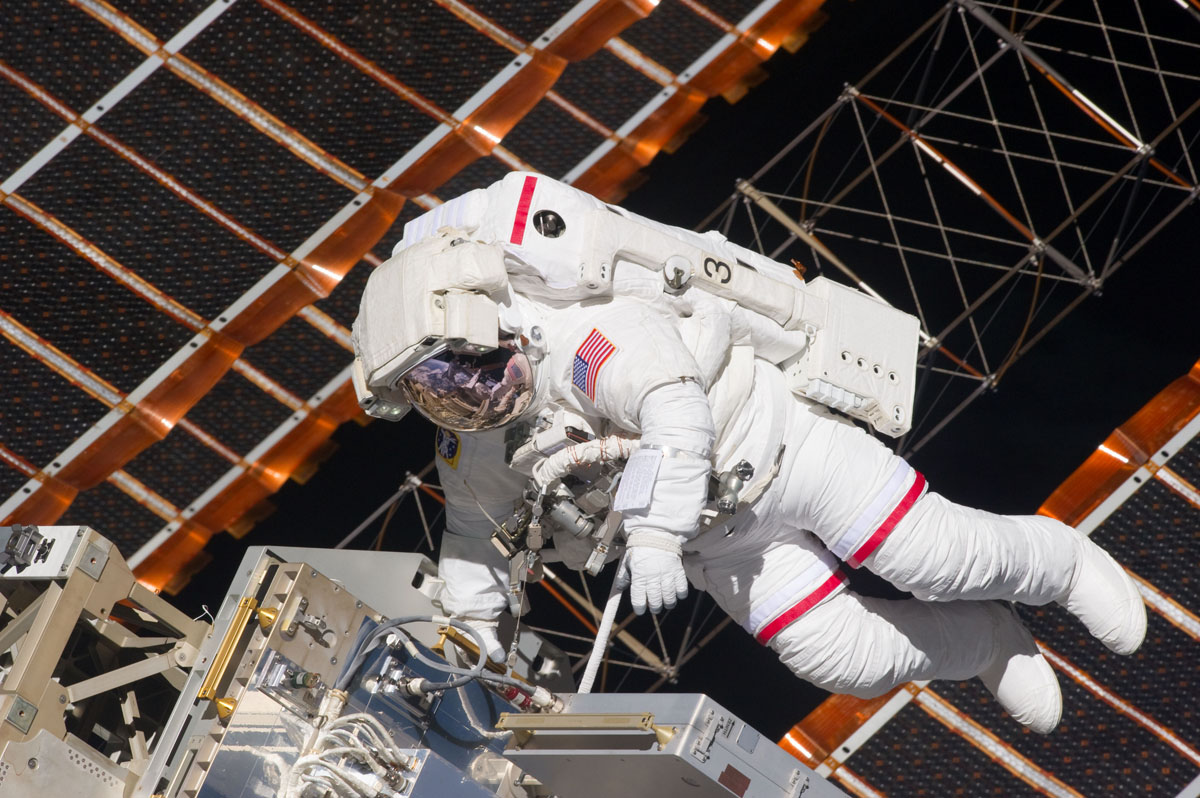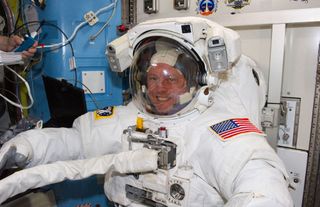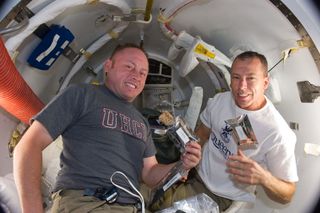For Spacewalking Astronauts, Itchy Eyes Are One Pain of Many

HOUSTON – When you have an itch you just can't scratch, it can be an annoying experience. But imagine how it feels for an astronaut on a spacewalk, sealed inside a bulky spacesuit. With so much gear on, even the tiniest discomfort can be an astronaut's worst nightmare.
Take the case of Endeavour shuttle astronaut Andrew Feustel. On Wednesday (May 25), he was spacewalking outside the International Space Station when a bit of helmet cleaner got in his eye. The result: A stinging, teary time in space until he could find a way to ease the pain.
Two other Endeavour astronauts ventured outside the space station today (May 26) on what is set to be the mission's fourth and final spacewalk. Those spacewalkers, astronauts Mike Finke and Greg Chamitoff, most likely expect at least a few aches to accompany their work.
While NASA spacesuit technicians try to provide the most comfort possible for spacewalkers, sometimes they have to soldier through a little discomfort here and there. [Infographic: Cosmic Apparel over the Years]

There's no crying in spacewalks (or sneezes)
Astronauts must wear protective spacesuits whenever they leave their pressurized homes like NASA's space shuttles, the International Space Station or other spacecraft. NASA astronauts, in particular, wear what the agency calls Extravehicular Mobility Units (EMUs), hefty white spacesuits with backpacks packed with oxygen and other life support necessities.
NASA's EMUs are typically set to about one-third the atmospheric pressure at sea level on Earth, and 100 percent pure oxygen is pumped through the spacesuits so the astronaut wearing it can breathe comfortably. Essentially, spacesuits are tiny, one-person spaceships in which the wearer, once sealed inside, can't scratch, wipe away sweat or perform any other normal gesture until the spacewalk is over. [FAQ: How Do Astronauts Take Spacewalks?]
Get the Space.com Newsletter
Breaking space news, the latest updates on rocket launches, skywatching events and more!
So on Wednesday, when Feustel and Fincke worked on the exterior of the station for 6 hours and 54 minutes, they were hoping the only glitches would be with the tools they were using. But near the end of the outing, Feustel got some of his helmet's anti-fog solution in his eye, which caused it to water and sting.
"My right eye is stinging like crazy right now. It's watering a lot," Feustel radioed Mission Control at NASA's Johnson Space Center here. "The problem with tears in space is that they don't fall off of your eye."
To relieve the burning, Feustel managed to rub his eye on a foam block inside his helmet, which NASA calls a valsalva device. The device is attached to the inside of the helmet's visor, and astronauts can wedge their nose against it to help them clear their ears if needed, said STS-134 lead spacewalk director Allison Bolinger.
While tears in space don't fall down your face the way they do on Earth, sneezing in space – particularly if a spacewalker sneezes inside his or her helmet – can be a much messier affair.[6 Every Day Things That Happen Strangely in Space]
Sneezing is another thing astronauts hope to avoid while on a spacewalk. But if an ah-choo is inevitable, there are some tricks experienced spacewalkers have up their spacesuit sleeves.
Astronaut Dave Wolf, a veteran spacewalker, has said that the trick with sneezing is to have good aim, something that is actually taught to spacewalkers during training.
"Aim low, off the windshield, because it can mess up your view and there's no way to clear it," Wolf said during a previous flight of Endeavour in 2009.

Hungry, hungry astronauts
In addition to watery eyes or plugged ears, astronauts working in the vacuum of space might also have to contend with grumbling stomachs.
Spacewalks usually last between five to eight hours, and the astronauts must power through the work without any breaks for food. EMUs are equipped with a drink bag, so spacewalkers can take sips of water as they work, but they have to wait until the day's work is over before they can dig into a meal.
And while spacewalkers seem to just float against he backdrop of space, the work they do outside the spacecraft is much more arduous and taxing than it looks.
The pressurized spacesuits give astronauts a workout when they move their bodies, particularly their upper torso, arms and hands, NASA officials said.
Spacesuit gloves must be sized correctly to avoid finger and fingernail injuries, and some astronauts apply patch-like coverings to some parts of their hands to avoid any chafing that could rub the skin raw during an hours-long spacewalk. [Spacesuit Gloves Can Make Fingernails Fall Off]
"The main fatigue issue is hands, because you're pressurized to 4.2 pounds per square inch," Bolinger said. "Your natural suit glove wants to be outstretched, so when you bend your fingers, that can be hard work."
Spaceflyers undergo extensive training to cope with muscle fatigue, and do practice runs of spacewalk procedures in NASA's Neutral Buoyancy Laboratory, which is a giant swimming pool used for spacewalk training at the Johnson Space Center in Houston.
The four spacewalks of Endeavour's STS-134 mission are expected to be the final spacewalks of NASA's space shuttle program. This mission is Endeavour's final flight before being retired along with the rest of NASA's shuttle fleet later this year.
NASA does have one more shuttle flight planned after Endeavour lands. But the STS-135 mission on the shuttle Atlantis has no spacewalks scheduled. Instead, it will be the International Space Station's crew that will tackle any orbital work, mission managers have said.
Endeavour's crew is in the homestretch of a 16-day mission that delivered a $2 billion astrophysics experiment and other supplies to the space station. The shuttle launched May 16 and is due to return to Earth June 1.
You can follow SPACE.com Staff Writer Denise Chow on Twitter @denisechow. Visit SPACE.com for complete coverage of Endeavour's final mission STS-134or follow us @Spacedotcom and on Facebook.
Join our Space Forums to keep talking space on the latest missions, night sky and more! And if you have a news tip, correction or comment, let us know at: community@space.com.

Denise Chow is a former Space.com staff writer who then worked as assistant managing editor at Live Science before moving to NBC News as a science reporter, where she focuses on general science and climate change. She spent two years with Space.com, writing about rocket launches and covering NASA's final three space shuttle missions, before joining the Live Science team in 2013. A Canadian transplant, Denise has a bachelor's degree from the University of Toronto, and a master's degree in journalism from New York University. At NBC News, Denise covers general science and climate change.